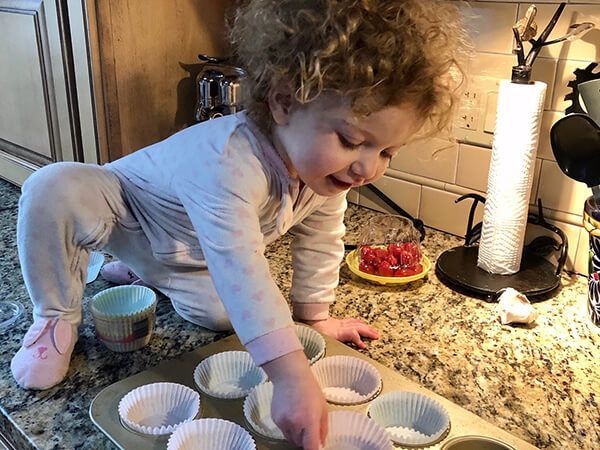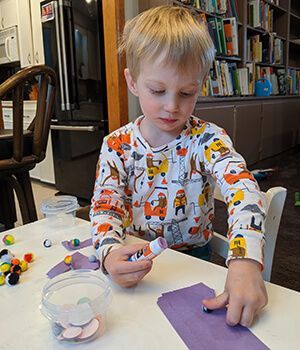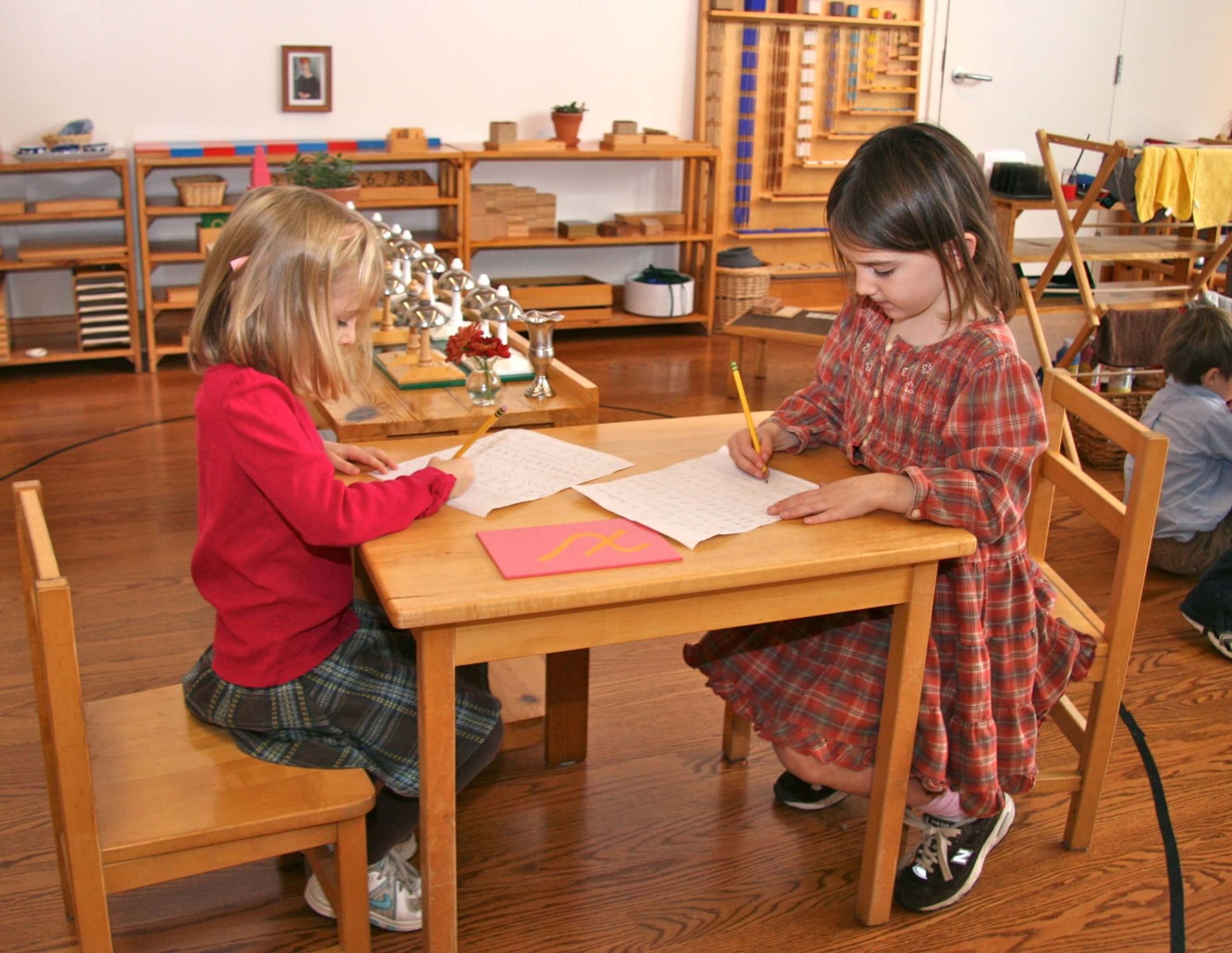
This is not easy. It is not easy for anyone. The governor of Illinois, and governors across the country, have called for a “stay at home” order, whereby families and individuals need to stay at home except for essential errands. Schools, state parks, playgrounds, and non-essential businesses are closed. Social gatherings of any kind are prohibited. This is not a time to be thinking about being productive, scheduled, or perfect. There is no right way to do “this.” In fact, the harder you try to do it right, the more likely you are to burn yourself out emotionally and physically. You are home with your small children. They are not going to school (or anywhere, really), and the world feels like an uncertain place.
Now is the time for grace. Grace for others and for yourself. It is the time for compassion, flexibility, and kindness. We do not know when life will return to normal again, or what exactly that normal will look like. The way we care for our families, our days, and ourselves needs to be sustainable. It will require effort over an extended period of time.
In this spirit, it is important to be intentional now about our own self-care and the rhythm of our days at home. By keeping these thoughts at the front of our minds, we can work to maintain energy and optimism during these trying times.
Self-Care
In my experience, good parenting requires taking advantage of the self-care we have available to us at any given time. In this indefinite period of isolation, we do not have our usual options and support for doing this. Social distancing has drastically affected our day-to-day experiences. We need to think creatively and graciously about what we actually can do, given these constraints. Simplification and self-compassion will come before all of our usual self-care habits.
Everyone’s recipe for self-care is going to look different, but some common ingredients are: Exercise, the outdoors, good food, reflection, and connection with family and friends. If we have time to take advantage of all of these in one day, then that is wonderful! But even if we only have time for one, or a part of one, it still will make a difference in our overall well-being. We can try writing a list of things we can do for ourselves and then be intentional about doing at least one per day. We can carve out a moment in the morning before little ones are out of bed, or set aside time during nap or rest time. We can swap with our spouses, even just for 20 minutes, so we each get time to do what we need to do to fill ourselves up. I find it helps if I put my exercise clothes on when I first wake up so that I can take advantage of the first 20 minutes of relief I get in a day to stretch or workout.
Now is not the time to feel guilty about doing what is necessary to care for our emotional well-being. We can take a break from the news for a day or two, go on a walk while our spouses help our children with breakfast, take a nap while our children do the nap, and set up a time when we are “unavailable” while we call a good friend. Our children did not need us for 24 hours a day before we all got stuck at home, and they do not need us for 24 hours a day now either! Of course, the younger they are, the more supervision and attention they require, but now is a time to work towards just a little more independence than whatever we have now. Those extra minutes that they occupy themselves are all precious and okay to enjoy!
Our self-care provides a source of energy for our well-being. Our well-being matters. Children, especially the youngest children, are barometers for our own emotional state. Perhaps because they are still emerging from a non-verbal state, they are so sensitive to all of our physical and physiological cues. This means that our tension and our anxiety both become a part of our children’s immediate environment. Whatever steps we can take to defuse that is beneficial to our whole household, and this is the crux of self-care.
None of this is to say that it is not okay to show your child that you are sad or scared. These are normal parts of the whole human experience! It is okay to cry, to be anxious, and to lose your temper. The important part is that you recover from these states and show your child that you have regained your equilibrium with your words and your actions. A healthy self-care routine will allow you to stabilize more readily, which is good for your children, as well as your own mental state.
Note: The rest of this post is written with parents of young children in mind, but parents with children of all ages may find it useful, or at least interesting!

Finding a Rhythm
When I think about being home with the youngest children, I like to use the word “rhythm” rather than “schedule.” I think that an over-emphasis on a schedule can create stress and a feeling of failing whenever I do not meet the exact times and goals that I set out for myself. With endless time stretched out before us, our goal can be to settle into a rhythm that meets the needs of everyone in the household, and is developmentally appropriate for our youngest children.
The rhythm that we find is not entirely adult-directed, nor is it entirely child-directed. Maria Montessori said, “Follow the child,” and to this end, we can consider what we know about our children’s pace, capability, and needs as we sort out how to make the most of our days. As we experiment with Practical Life work, art projects, building games, and going outside, we may find that there are different times of the day when children are more receptive to activities than others. Perhaps the morning invites more time for independence as they are most rested from a night of sleep. And perhaps the afternoon is the best time for going outdoors, as their bodies are yearning for fresh air and big movement near the end of the day.
If children are resisting the same thing every day, we can step back and consider a way to work around it. Maybe they need time looking at books before they participate in cleaning the kitchen. Maybe they want to start by doing work with their parent’s attention, and then have their parent disappear into the background as their own interest and work ethic takes over.
I recently spoke to the mother of two young children about how she is (loosely) structuring during days under social-distancing. No routine is prescriptive for every family, so this is merely meant as a suggestion. Every family needs to establish their own routine based on their individual family’s needs. She told me:

"In the morning, my children (ages 2 and 4), wake up and read books in bed. They join me downstairs when they are ready for breakfast. We eat breakfast slowly, talking and telling stories. Afterwards, one will usually help me clean up while the other plays under my feet. They help for as long as they are interested. Once the kitchen is clean, we usually start on a baking or cooking project together, which I invite them to but do not require. They help with the parts they can, and then one might drift off to find something else to do. After our project is over, we either read books together or go for a walk. We have lunch around the same time every day, and then it’s nap and quiet time. After quiet time, we have a snack together, and then we go outside if we haven’t done that already. When we are ready to come in, they usually will want to play with their blocks and animals, or else we set up some opportunities for artwork—painting, drawing, gluing—or Practical Life. If it’s nice, we may even go back outside! Then it’s time for dinner, which I have either prepped in the morning with them, or I invite them to help me prepare now. If they are tired and having trouble being independent, now can be a good time for music or a simple audiobook. Or else I can set them up at the sink with water and dishes. They are always happy when water is involved! We have dinner together, a prolonged bathtime, and then it’s time for pajamas and bed."
A routine may look something like this, and it may look nothing like this, and that is okay! The purpose in sharing this is to give a sense of how to structure a rhythm that has flexibility built into it, rather than a schedule that makes a parent feel bound to it.
Trouble-Shooting
On any day there will be plenty of ups and downs! Children may fight with each other, resist naps and quiet time, resist activities, encroach on parents’ work and self-care time, and generally act like young children. There is no solution that will work for every child every time, but here are some ideas for when these arise:
Siblings Fighting
Solutions for this problem vary greatly depending on the ages and personalities of the children involved. The first and most important step is accepting that siblings arguing is normal and good! They are learning that other people have needs, they are learning that they cannot have everything they want, they are learning how to communicate, and they are learning how to argue and make up. Just because they are fighting, does not mean something is wrong! Once we can acknowledge that fighting is normal, we can ask whether their disagreements are something that is a problem for them, or are they just a problem for us! I used to respond to my children’s fighting with a hair trigger nerve. I hate conflict! And I felt like it needed to be resolved. But once I could take a step back and see that no one was being (badly) hurt emotionally or physically, I could give my children more space to work it out on their own. If it was bothering me, I could just step into another room. I was amazed at what they worked out for themselves.
When the fighting does become intolerable or unacceptable, it can be wise to give everyone a break from one another for a short period of time. This is not a punishment—it’s just a chance to take a breath! This may mean everyone playing in their rooms for a few minutes, or giving the older child some space while the adult occupies the younger child. We also can set up different work stations in the house for children, allowing each to protect their space as an area to be on their own. Similarly, if there is one particular object that tends to become a source of conflict, it may be wise to give everyone a break from that toy. This can be done in a positive way: “Everyone loves the doll with brown hair. I am going to put her in the closet for a little bit while we find a way that you can both play with her peacefully.” Then turn to another activity for a while.
Resisting Naps and Quiet Time
There can be many reasons that a little one is resisting naps. Sometimes they are overtired because they are not getting enough sleep at night, sometimes nap is starting too late or too early, sometimes they are overstimulated by activities that came before naptime, and sometimes they are distracted by too many toys and books in their room. Parents can experiment with all of these variables as they figure out the reason their particular child is resisting.
We used quiet time in our house to replace nap time once our children outgrew that, so that I could get a break in the afternoon, and so that our children could have time to rest and recuperate from the morning. Building in time for rest and reflection is an important life habit. For our family, quiet time means playing or reading quietly in your room for at least one hour after lunch. Some families choose to restrict this to only reading, and some families allow children to play quietly in other areas of the house. These guidelines will be unique to every family. If a child is new to quiet time, they can start with a short amount—maybe 15 minutes—and then work up to an hour over time. Expectations must be clear before quiet time begins, along with desirable (and reasonable) plans for what will happen after a successful quiet time—perhaps baking cookies or a walk in the woods.
Resisting Activities
What to do when little ones resist activities? The truth is that before the age of 6, and certainly before the age of 3, it is very hard for a child to do something they do not want to do. It is far more important that they learn to inhibit bad actions (hitting, yelling, spitting) than that they do exactly what a parent tells them to do exactly when they say to do it. If they are refusing to engage in an activity that a parent suggests, we can first ask ourselves, “Is this necessary? Do they really need to sweep with us?” The answer is “Probably not.” In these cases, it is best for us to let them choose something they do want to do, and invite them again at a later time.
Of course, there are some actions that we really do expect them to do: Perhaps clear their place at the table, or try to sit on the potty. For these kinds of cases, we can set up a logical chain of events that we know they will want to participate in. “We can read books together after you clear your plate. You can do it when you are ready.” Or, “We will play outside after you sit on the potty. It’s okay if you don’t go. All you have to do is sit. You can do it when you are ready.” By creating these chains of events, you remove the confrontation. They have a choice to make, and their lives will be better if they make the “right” choice!
Encroaching on Work and Self-Care Time
Again, solutions to this problem vary greatly depending on children’s ages and personalities, as well as the needs of the adults at this time. In homes where both parents are trying to work during this time under the “stay at home” order, with children at home and no child-care, I would use one of my favorite parenting phrases, “Surviving is thriving.” Finding ways to get work done with very young children around is a near impossible situation, and, again, grace and flexibility is bound to be a large part of these solutions. Parents working as a team, working in shifts, swapping in and out, and being creative and adaptable are of the utmost importance.
Babies need constant supervision, as well as a great deal of attention. If a littlest one always wants to be in their parents’ arms or engaged, the parent can start working slowly towards a little more independence. This means that when the baby is playing with a toy, the parent can be nearby but working on something else. When the baby starts to fuss, do not pick them up right away. See if they can settle a bit before picking them up. In this way, the baby can gradually build up stamina for being in their own company.
As children get a little older, they develop a better understanding for when the adult is not available. It is okay not to respond to a child’s every beck and call! A parent can say, “I love you and I am here for you if there is an emergency, but right now I am not available. I will be with you again in 10 minutes.” In this way, a child can come to understand that adults have lives and needs too. They feel safe and loved in their house knowing that their needs are met. Constant attention does not equate with security.
Activity Ideas
Practical Life
- Set up a cleaning kit for your children and invite them to clean different areas of the house (walls, door knobs, windows, chairs, tables)
- Put a little water in the sink and give them (not very breakable) dishes and kitchen utensils to clean for as long as they want
- Find a crock pot recipe with a lot of vegetables and invite them to help you prepare the vegetables, dump the ingredients in the pot, and turn it on
- A pouring activity: set up a few small pitchers or cups with a little water in them; show your little one how to practice pouring the water from one container to another
- A spooning activity: set up two small bowls with a spoon; put a small amount of dried rice or beans in one bowl; show your child how to spoon the dried goods from one bowl to the other

Art
- Set up gluing activities with different kinds of shapes that you rotate every few days or weekly (butterflies, flowers, leaves, circles, clouds)
- Make your own play-dough and use it
- Paper weaving (cutting strips of paper and then weaving them together to make decorations)
- Use an easel or large piece of paper taped to the table for painting
Language
- Go on a walk and talk about the different color houses
- Make a set of color cards with cardstock and markers (Red, blue, yellow, green, purple, orange, white, black, brown); lay out the cards and then name the color and carry each card to something in the house that matches the color; play again, only this time, bring something to the mat that matches the color
- For children who are learning their numbers: Make a set of cards with numbers on them (start with just 1, 2, 3); lay them on a rug or table; go into the house and choose one item to place next to the number one, two similar items to place next to the number two, etc.
- Give them instructions for something to find in the yard—a green leaf, three rocks, two pinecones, etc.
Final Thoughts
During this time, one of the most important things we can do for ourselves that falls under the category of self-care and finding a rhythm is simplify. Now is not the time for us to create a home that replicates school, it is not time to worry about our children’s academics, and now is not the time to try to figure out the right way to do it. There is no right way. The most important thing we can give our children right now is ourselves—our presence, our stability, our calm. If we can find little ways to care for ourselves and guide our families into a rhythm that provides security, then we can be that safe place for our children. And our home will sustain them as we navigate these times.


